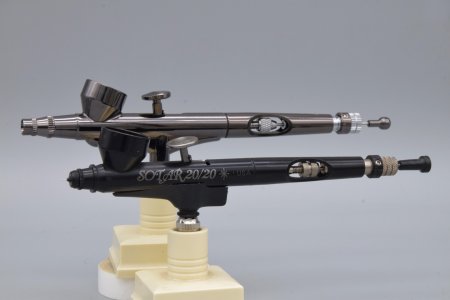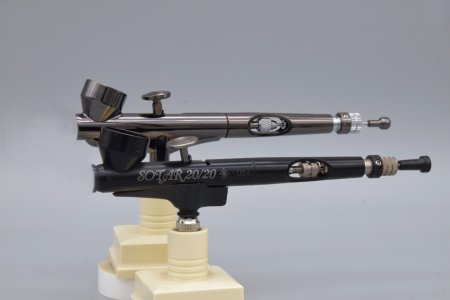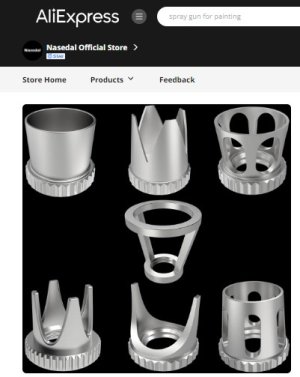You are using an out of date browser. It may not display this or other websites correctly.
You should upgrade or use an alternative browser.
You should upgrade or use an alternative browser.
$19 Generic Asian Sotar look alike - pleasant surprise
- Thread starter DaveG
- Start date
Airbrushkid
Double Actioner
First off Chinese copy everyones product. Olypmos was the first over 50 years or more. My brain to old now to remember everything.


Airbrushkid
Double Actioner
Airbrushkid
Double Actioner
Please do correct me if I am wrong.
Wizard_Theron
Mac-Valve Maestro!
I have no control whatsoever!! My therapist gave up on Me
Yep £15.88 with tax and free shipping.
View attachment 87821
I put it in my basket. But…
tatocorvette
Detail Decepticon!
That SOTAR flyer is a from when the SOTAR V was released. Maybe about 5 years ago or so.
Airbrushkid
Double Actioner
But it shows the Sotar 20/20 in the picture.That SOTAR flyer is a from when the SOTAR V was released. Maybe about 5 years ago or so.
tatocorvette
Detail Decepticon!
There are 3 SOTAR models:
Slim (top picture) with A cup (essentially no cup at all)
Standard with the B cup (2 ml) The standard is usually called just the "20/20" but all are marked as 20/20
SOTAR V with the larger cup
There are also 3 setups for each: Fine, Medium and Heavy.
There are also older and new design variations (removable vs fixed head) and many other changes thru history like cup designs.
Thanks,
Ismael
Slim (top picture) with A cup (essentially no cup at all)
Standard with the B cup (2 ml) The standard is usually called just the "20/20" but all are marked as 20/20
SOTAR V with the larger cup
There are also 3 setups for each: Fine, Medium and Heavy.
There are also older and new design variations (removable vs fixed head) and many other changes thru history like cup designs.
Thanks,
Ismael
DaveG
Airbush Analyst
Airbrushkid
Double Actioner
Why you block to front of both airbrushes. Does the Real Sotar still have the plastic piece on the bottom with the air value assembly? Or did they make it metal?
Airbrushkid
Double Actioner
DaveG
Airbush Analyst
I blocked the fronts because that is the only place the two really vary - from the front edge of the full body diameter in front of the color cup to the tip of the handle the dimensions between the two are almost exactly the same (build varies, though).Why you block to front of both airbrushes. Does the Real Sotar still have the plastic piece on the bottom with the air value assembly? Or did they make it metal?
Plastic, as in the photo - this is the most recent version of the Sotar.

Airbrushkid
Double Actioner
Thank you Sir. All I had said it looked like a mix breed of HP-B and Sotar 20/20. Wow even the trigger looks like Iwata. Badger looked skinny. The slot behind the the trigger on the real Sotar is not on the $19.00 model.
Thank you. And I'll leave you alone before someone gets mad at me.
Thank you. And I'll leave you alone before someone gets mad at me.
RK Ink and Focus
Mac-Valve Maestro!
Thanks Dave, I was just interested as I was wondering if the length between airvalve to tip had improved its characteristics. Compared to the picture of the Chinese 130s your pd150 looked shorter. I was not trying to be an ass if I came across like that. It is very similar to the sotar behind the head isn't it.
DaveG
Airbush Analyst
I don't have any of the 130 (or similar) models here. The one thing I will mention is that the trigger is fairly close to the color cup. I don't think there would be room for the typical "C" cup that most of the 130's seem to use. I am sure the "in front of the color cup" portion is about the same. I've got a pretty good selection of Japanese "B" cup brushes, and this one makes me think Sotar before any of themThanks Dave, I was just interested as I was wondering if the length between airvalve to tip had improved its characteristics. Compared to the picture of the Chinese 130s your pd150 looked shorter. I was not trying to be an ass if I came across like that. It is very similar to the sotar behind the head isn't it.
tatocorvette
Detail Decepticon!
DaveG
Airbush Analyst
I think in terms of the length of the "in front of trigger" length, this is probably a pretty good approximation between a 130 and this brush - the brush in the back is an Iwata HP-C+. It is the same length as the original HP-C trigger to tip, with the difference being the angle and shape of the color cup between the two. This brush is a good bit shorter trigger to tip - so does move your hand closer to the work surface in comparison.Thanks Dave, I was just interested as I was wondering if the length between airvalve to tip had improved its characteristics. Compared to the picture of the Chinese 130s your pd150 looked shorter. I was not trying to be an ass if I came across like that. It is very similar to the sotar behind the head isn't it.

Pretty sure the black chrome plating I have in inventory will be a good match...Hmmmm..... the desire to grind that front cap into a 2 prong I sense... match the color, the challenge will be...
DaveG
Airbush Analyst
DaveG
Airbush Analyst
Public service notice  - someone reported to me that they put acetone in the color cup of one of these brushes, and left it for a period of time. When he came back, the interior of the cup had what looked like a crinkled up clear coat in it. He dumped it, and wiped out the cup. The brush continues to work fine, and there is still color in the cup - so, it looks like it was some sort of top coat? I myself have been using acetone as part of my flushing routine, but always after water, and then followed by water and have experienced no issues - but, do beware there could be an issue with the finish and prolonged exposure to solvents.
- someone reported to me that they put acetone in the color cup of one of these brushes, and left it for a period of time. When he came back, the interior of the cup had what looked like a crinkled up clear coat in it. He dumped it, and wiped out the cup. The brush continues to work fine, and there is still color in the cup - so, it looks like it was some sort of top coat? I myself have been using acetone as part of my flushing routine, but always after water, and then followed by water and have experienced no issues - but, do beware there could be an issue with the finish and prolonged exposure to solvents.





